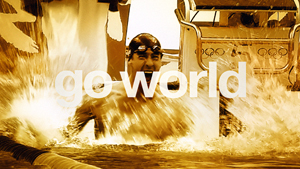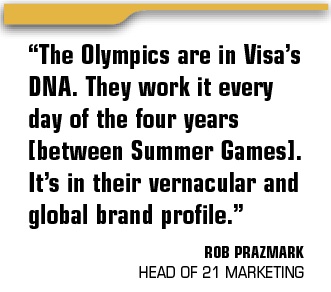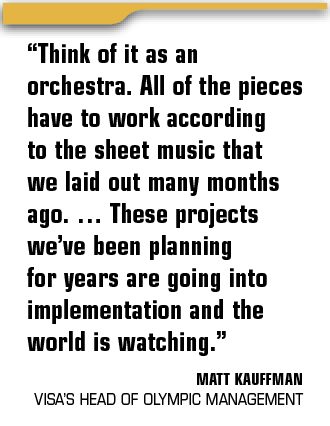Editor's note: This story is revised from the print edition.
Four years ago, on the day after China mesmerized the world with the synchronized beat of 2,008 drums, Visa’s top marketing executives and London Olympic organizers gathered for dinner at a traditional Chinese restaurant in Beijing’s financial district.
It was an informal gathering, but it was an important first step in Visa’s preparation for this week’s London Games. It allowed Visa chief marketer Antonio Lucio and his team to connect with London leaders Sebastian Coe and Paul Deighton and forge the backbone of a partnership that has lasted the past four years.
The Olympics demand more time and attention than almost any other sports sponsorship. Companies with worldwide rights spend years creating marketing programs that stretch across hundreds of nations and an array of languages. Their estimated marketing spending can soar to more than $250 million.
It’s a massive undertaking, and over the last 26 years, Visa has distinguished itself among Olympic marketers by being the first out of the gate with memorable campaigns that have driven significant business. Its first campaign in 1988 — “bring your Visa card, because the Olympics don’t take American Express” — set in motion its move from third in the credit category to first, and it has used the Olympics to maintain that position ever since.
“The Olympics are in Visa’s DNA,” said Rob Prazmark, the head of 21 Marketing who sold Visa its first Olympics sponsorship in 1985. “They work it every day of the four years [between Summer Games]. It’s in their vernacular and global brand profile.”
Over the course of the last three months, and through more than a dozen interviews, Visa executives pulled back the curtain on their marketing efforts ahead of the London Games to reveal what it takes to design the creative, select the athletes and develop an on-site activation plan that allows the company to reap the rewards of its $100 million Olympic sponsorship.
It’s a complex process that can be traced from a dinner in Beijing to the Olympic superstore in Hyde Park.
A campaign is born
It was early 2008 when the creative team at TBWA got a brief from Visa calling for a new ad campaign to replace “Life takes Visa.” Lucio, who had become the company’s new chief marketer, wanted a slogan that underscored the values endemic to the company and the Olympics.
TBWA Executive Creative Director Patrick O’Neill’s team went to work immediately. The first idea they developed showed Visa supporting athletes by holding them up with hands.
Visa nixed it.
The next idea showed Visa athletes pushing the continents of the world together.
Visa nixed that, too.
Time was running out on the creative team when they decided to move from complex metaphors to stories about
athletes’ courage and success, stories that packed an emotional punch.
“That’s how we ended up with this idea of ‘Go Humans,’” O’Neill said.
The slogan originally had been developed by TBWA for the International Olympic Committee in 2000, but the IOC opted for “Celebrate Humanity” instead. O’Neill revived it for Visa because he thought it matched the company’s effort to support athletes.
In February, he and his team traveled to Visa’s headquarters in San Francisco loaded with “Go Humans” print ads, storyboards, scripts and pictures. They presented the idea to Visa’s senior marketing staff.
Lucio liked it, but he worried it was too emotional. He wanted to cut some of the emotion out of it. TBWA’s creative team pushed back, saying that the emotion drove the campaign and that scaling it back would undermine the campaign. Creative prevailed, and Lucio took the idea to Switzerland to share it with the IOC.
“We were kind of blown away,” said Timo Lumme, IOC managing director of TV and marketing services. “It was profound.”
But Lumme said there was one problem. Nongovernmental organizations were hammering the IOC and its sponsors over China’s human rights abuses ahead of the Beijing Games. Lumme asked: Wouldn’t “Go Humans” add fuel to their fire, or at the very least look tone deaf?
The observation led TBWA to change the slogan to “Go World.” The campaign, which ran exclusively in the United States, featured actor Morgan Freeman’s deep voice telling the stories of historic Olympic moments as sepia-toned, still images of athletes scrolled across the screen.
Visa’s marketers became so enthralled with the concept in the ensuing months that by the time they met with London leaders in China that summer in 2008, they were already making plans to use it in London four years later. They even joked with Coe, a 1,500-meter gold medalist in the 1980 and 1984 Olympics, about featuring him in one of the spots.
“It seemed like a very winning concept,” said Jennifer Bazante, Visa’s head of global brand marketing and strategy. “It’s based on this universal human truth: removing borders, barriers and boundaries. It’s a great idea, and we did some investigation of how we could bring it to life in different markets.”
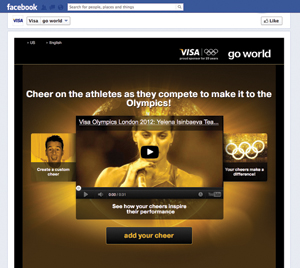 |
Visa’s Facebook page gives fans a chance to encourage Olympic athletes with cheers.
|
Visa spent time after the Games testing the slogan in markets like Russia and Brazil before deciding to take it global. This summer it will be used in 70 countries and at 1,000 banks, making it the largest, single campaign the company has developed for an Olympics.
For London 2012, Visa marketers pushed TBWA and its digital agency partners, Socialarc and Atmosphere Proximity, to incorporate social and digital media into the campaign. It fits into Lucio’s belief that Visa must be where consumers make purchase decisions, and increasingly they do that online.
The company is encouraging fans to cheer on its 60 sponsored athletes, such as U.S. swimmer Michael Phelps and volleyball player Kerri Walsh, by submitting digital “cheers” through clicks, posts, photos and video on Visa’s Facebook page. TBWA will incorporate those cheers into advertising spots congratulating athletes on their performances this summer.
“In the past, it was Visa cheering the athletes on, but we wanted to invite the world to cheer the athletes on, as well,” Bazante said. “By harnessing [all these cheers], you can really inspire the athletes.”
Building Team Visa
During the 2000 Olympics in Sydney, Michael Lynch, then-Visa senior vice president, was looking for athletes the company could sign for the Athens Games. Everyone he spoke to at the U.S. Olympic Committee, USA Swimming and other organizations recommended a 15-year-old swimmer named Michael Phelps.
But Lynch had reservations. The kid was young. He didn’t even medal in Sydney. Could he really be a star?
It wasn’t until Lynch spoke to his neighbor that he changed his mind. The neighbor’s daughter swam competitively and told Lynch he would be a fool not to have Visa endorse Phelps.
In 2002, the company became Phelps’ first non-endemic sponsor, and it’s made him a centerpiece in its Olympic
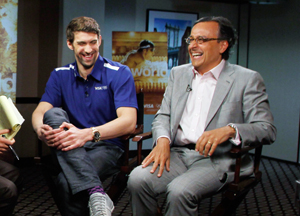 |
Michael Phelps and Visa chief marketer Antonio Lucio attend a “Go World” media day in May in New York City. Visa nearly passed on signing the swimmer early in his career.
Photo by: Getty Images |
marketing ever since. He’s one of more than 60 other athletes today who are the foundation of the company’s “Go World” campaign.
Visa has put Olympians front and center in its marketing for the last decade. The Team Visa athletes, as they are called, were what inspired TBWA to create the “Go World” spots.
The way Lynch identified and signed Phelps in 2002 is indicative of the company’s approach to selecting athletes. It has sponsorships with top national governing bodies like USA Track & Field and the U.S. Ski & Snowboard Association, which give it access to insights on who the stars of tomorrow might be. It also enlists GMR Marketing to help it keep spreadsheets tracking the performance of U.S. and international athletes in competitions worldwide.
The company historically signed undiscovered athletes for three reasons. First, it increased the likelihood the athletes would thank Visa first in interviews. Secondly, it allowed the company to build long-term equity in the athletes. And finally, it gave them leverage at the negotiating table, which reportedly has allowed Visa to pay as little as $10,000 for an endorsement.
In addition to looking for undiscovered athletes, Visa looks for athletes representing new sports in the Olympics. That’s why it signed boardercross star Seth Wescott in 2006 and beach volleyball stars Walsh and Misty May-Treanor in 2003. It also looks for athletes with compelling stories to tell, such as U.S. distance runner Lopez Lomong, who signed before the London Games in large part because of his backstory as one of Sudan’s “Lost Boys.”
Visa’s approach to signing athletes has evolved since 2008. With the “Go World” campaign now reaching 70 markets, the company’s Olympic marketing team has centralized responsibility for signing international athletes.
In many markets overseas, it will sponsor only one or two athletes, and as a result, it has begun signing more recognizable stars. It signed tennis player Li Na in China, and distance runner Paula Radcliffe in the U.K.
“We have to make a decision: Do we go with an athlete that’s established or one that’s an up-and-comer?” said Matt Kauffman, Visa’s head of Olympic management. “You have to understand how each market consumes the Olympics. In some, they’re really focused on a hero, and if you can get that hero, that can be huge.”
The “Go World” campaign has added another wrinkle to the company’s approach. Because the campaign focuses on athletes, TBWA has brought some stories to Visa and asked the company to find an athlete to fit the creative.
For example, Visa's ad agency in Brazil, BBDO Brazil, had the idea for creating a spot that showed a diver plummeting from the tallest building in the world. Visa marketers liked the idea but didn’t have a diver, so they went out and signed David Boudia to star in the commercial.
“It was so compelling we felt we needed to do it,” Kauffman said.
The athletes are more than the centerpieces of Visa’s TV and print creative. They also cover buses in Olympic cities and bags at Olympic stores. They’re the glue for everything the company does.
The way to pay
On the first Wednesday in July, Kauffman joined dozens of people waiting in line for the opening of the London 2012 store in Hyde Park. He picked out T-shirts for his kids and headed to the checkout line.
As he entered the line, stanchions greeted him that read: “Visa accepted.” The blue wall to his left showed images of a half-dozen team Visa athletes wrapped around the words “We are proud to accept only Visa.” A massive image of Phelps diving in the water dominated the wall in front of him.
This was the epicenter of Visa’s on-site activation in London, and Kauffman thought it looked phenomenal. His Olympic
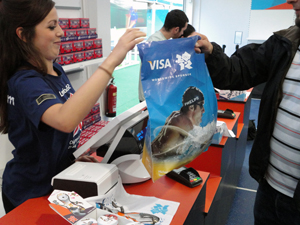 |
Visa’s point-of-sales team has planned for every possible issue that could arise.
Photo by: Visa |
team had worked more than a year on the Visa branding around him and every shopper in the store would leave knowing Visa supported the London Games.
Visa is unique among Olympic sponsors in how it promotes its brand on-site. Most sponsors have spent millions designing and erecting brand showcases at the London Games. The structures introduce visitors to new Samsung products and allow them to sample Coca-Cola. But Visa doesn’t ever have one.
The company’s rights as the official payment system of the Olympics allow it to take a different approach.
“We have the largest number of intersections between our category and the organization of the Games,” said Ricardo Fort, Visa’s new head of sponsorship. “Because we’re processing and facilitating payments, we touch everything.”
Instead of building a showcase, Visa builds a payment system that guarantees people can use their Visa cards to buy everything from T-shirts at the Olympic store to hamburgers at McDonald’s.
Turnkey Sports Poll
 Which TOP sponsor is doing the best job activating its partnership with the Summer Olympics?
Which TOP sponsor is doing the best job activating its partnership with the Summer Olympics?
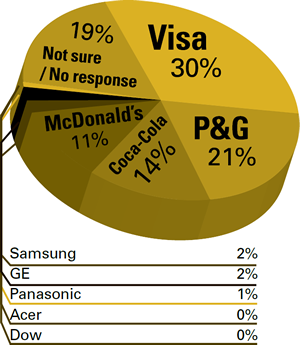
 How would you rate the value of a TOP sponsorship of the Summer Olympic Games?
How would you rate the value of a TOP sponsorship of the Summer Olympic Games?
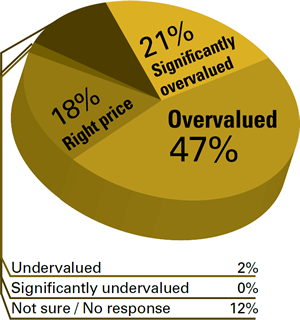
Source: Turnkey Sports Poll, June 2012. The survey, conducted by Turnkey Sports & Entertainment in conjunction with SportsBusiness Journal, covered more than 1,100 senior-level sports industry executives spanning professional and college sports.
The company this month has installed 3,200 credit card machines across 34 Olympic venues and three Olympic stores. It has posted 250,000 individual Visa logos at point-of-sale locations and delivered 3.2 million Visa-branded shopping bags for the Olympic stores to give customers.
It’s a massive undertaking. Every day over the last month, Kauffman led morning meetings with Visa’s point-of-sale, brand and communication teams to evaluate their progress.
The point-of-sale team consistently ran into the most trouble. Telecommunications and power were the last things made operational at many London venues, so installing credit card machines often got delayed.
Getting those machines installed and working is priority No. 1 for Visa. The company knows that if those machines don’t work, it will face immense public criticism. It already experienced that once ahead of the London Games.
When London organizers put tickets on sale in 2011, they declined to accept Visa cards that expired that August. When hundreds of people weren’t able to buy tickets, the press came down hard on Visa. Though the decision to decline cards was made by the organizing committee, the company issued a public apology.
To prevent mistakes like that during the Games, Visa’s point-of-sales team planned for every possible issue that could arise. It even trained London venue managers on working through a natural disaster or a terrorist event.
“Think of it as an orchestra,” Kauffman said. “All of the pieces have to work according to the sheet music that we laid out many months ago. … These projects we’ve been planning for years are going into implementation and the world is watching.”
Visa’s branding extends beyond the venues and throughout London. The company collaborated with its sister company, Visa Europe (see related story), to wrap 460 taxis and 50 buses that will be driving around town. It also has more than 200 signs spread throughout Paddington Station, Heathrow Airport and Westfield London mall, where 80 percent of visitors will arrive to enter the Olympic Park.
More than 90 percent of restaurants and retailers in London accept Visa, and providing them all with Olympic-themed branding would be impossible, so the company decided to limit what it provides to the city’s Covent Garden area. Some 200 retailers in the area will showcase posters with Visa athletes and the London 2012 logo.
Online Updates From London
SportsBusiness Journal and SportsBusiness Daily today will be launching a comprehensive, daily website devoted to the London Olympics and the business behind it. The site, which will be accessible at www.sportsbusinessdaily.com/
SB-Blogs/Olympics/London-Olympics, will be free and run through Monday, Aug. 13, the day after the closing ceremony. SportsBusiness Journal Olympics writer Tripp Mickle and media writer John Ourand will be in London providing news updates, people pieces and personal insights from the Games. Among the features will be daily updates on sponsor news and activation, athlete endorsements, and media coverage, as well as keeping up with the people and events from the sports business industry.
“The beauty in that is that it allows the merchant community to get involved in the Games,” Kauffman said.
The only other Visa signs visible in the coming weeks will be ones held aloft by hospitality tour guides. Visa will host thousands of guests from around the world during the Games. The bulk of the guests will be sweepstakes winners who won a trip to the Games through one of 250 banks worldwide.
At the same time Visa is taking those customers to Olympic events, its senior marketing team will be sitting down to a special dinner for the leaders of the Rio Games. The dinner will be informal, just as the dinner it hosted for London 2012’s Coe was a few years ago, but Visa’s message will be clear.
“We have a lot of people who have gone through many, many Games,” Fort said. “Our role is to open their eyes to everything they’re going to go through.”
It’s a process that begins with a meal and won’t end for four more years.
Bring your Visa card: Olympic marketing highlights
■
Calgary 1988: Visa’s first Olympic Games sponsorship features the iconic campaign: “Bring your Visa card, because the Olympics don’t take American Express.”
■ Seoul 1988: Continues its “Olympics don’t take American Express” campaign; accuses American Express of ambush marketing after the rival uses footage with the Olympic stadium in an ad.
■ Albertville 1992: Develops marketing programs activated through financial institutions and merchants worldwide; enhances local presence marketing.
■ Barcelona 1992: Develops and promotes an on-site Olympic art exhibit.
■ Lillehammer 1994: Introduces Visa Travel Money.
■ Atlanta 1996: Creates Olympians Reunion Centre with the World Olympians Association.
■ Nagano 1998: Uses Olympic merchant programs as a model to expand domestic card acceptance and usage in Japan.
■ Sydney 2000: Visa International launches its “Kangaroo Dream” ad campaign, promoting travel and tourism in Australia.
■ Salt Lake 2002: Records its highest level of global banking and partner participation for a Winter Games; record point-of-sale volume; begins Paralympic Games sponsorship.
■ Athens 2004: Creates the global Team Visa program with Michael Phelps, Kerri Walsh and other Olympians.
■ Torino 2006: Creates Visa Championships — Torino 2006, an online game and international competition; Visa USA features Bode Miller, Jonny Spillane and Michelle Kwan in “Life takes Visa” ads.
■ Beijing 2008: Adds approximately 90,000 ATMs and signs up 216,000 merchant acceptance locations or outlets throughout China; hosts more than 8,000 guests; turns over the operations of the Olympians Reunion Centre to the World Olympians Association.
■ Vancouver 2010: Introduces its first Olympic-themed global marketing program, Go World, following the successful use of the slogan in the U.S. only during the Beijing Games.
Sources: Visa, SportsBusiness Journal research


